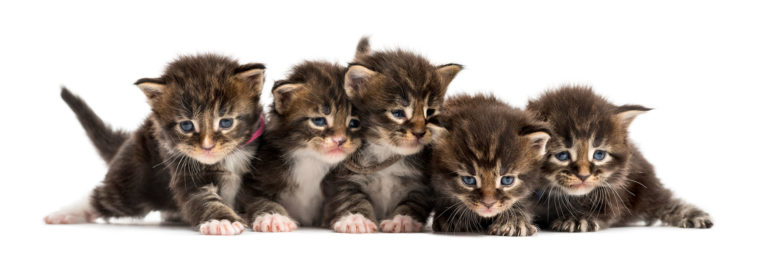Congratulations on adopting your new kitten! We’re excited to partner with you in keeping them happy and healthy for many years to come. At Shawsheen Animal Hospital, one of our main recommendations for kitten care is a series of three exams, 3-4 weeks apart, shortly after adoption. It’s important to ensure a good start for your kitten so they can grow normally and become a healthy, active adult.
Our Recommendations for Your Kitten’s Exams
Below are our general treatment recommendations at your kitten’s series of exams.
First Exam
Your kitten’s very first exam should ideally be when they are about 8 weeks old. However, the initial visit still counts as a first exam as long as your kitten is under a year old.
Recommended Kitten Vaccines
- Feline Leukemia/AIDS combination test
- Leukemia Vaccine
- FVRCP vaccine (distemper)
- Fecal exam
- Dewormer
Second Exam
The second exam serves as a recheck from your kitten’s first exam. Your kitten should be about 12 weeks old now, and we want to take some time to evaluate their health and growth.
Recommended Kitten Vaccines
- FVRCP vaccine (distemper)
- Leukemia Vaccine
- Rabies Vaccine
Third Exam
When your kitten comes in for their third exam, they should be around 16 weeks of age. We will once more assess your kitten’s growth, and we’ll finalize their kitten shots to make sure they have proper protection from disease. This will also be the time we discuss your kitten’s eventual transition into adulthood.
Recommended Kitten Vaccines
- FVRCP vaccine (distemper)
- Leukemia Vaccine
How Do I Prepare My Home for a Kitten?
Here are some tips for a smooth transition into having a kitten-friendly home.
What essential items do I need for my kitten?
- Scratch posts and other scratchable surfaces to keep your kitten away from the furniture
- Litter boxes
- A cat carrier (or two)
- Stainless steel or ceramic food and water bowls
- Stain and odor remover in case of accidents
What Should I Remove from My Kitten’s Environment?
- Toxic flowers and plants
- Toxic cleaners and sprays
- Human medication
- Small objects that could be a choking hazard for a curious kitten
What Does My Kitten Need to be Comfortable?
- A soft bed that’s easy to clean
- Small, cozy places for your kitten to hide
- Various grooming supplies (brush, nail clippers)
- Feline pheromones to let cats know they are safe in a new environment
Playing with Your Kitten
Kittens love to play, and it’s essential to their development and enrichment.
How Can I Play Safely with My Kitten?
- Have a designated room or space for playing
- Use cotton chew toys, or plush or feather toys on a string
- Anything that jingles
- Tunnels can also be fun for kittens to play and sit in
- Avoid using your hands as a toy for your kitten, as they could get in the habit of nipping!
Why It’s Important to Play with Your Kitten
- Playtime helps you establish and build a strong bond with your kitten
- It gives your kitten a chance to release pent-up energy
- Playing can occupy your cat and prevent them from damaging furniture
How Frequently Should I Play with My Kitten?
- You should play with your kitten at least 20 minutes a day
- Additionally, set aside at least 2 separate play times each day, preferably one in the morning and one in the evening
Tips for Feeding Your Kitten
Here are some general kitten feeding tips.
How Often Does My Kitten Need to be Fed?
- Dry food only: Can be left available throughout the day, but be mindful that some cats like to snack and can be prone to weight gain if food is always available to them
- Wet food only: Feed your kitten at least 4 times a day
- Combination: Give your kitten wet food twice a day, and leave some dry food available
What Kind of Food Should I Give My Kitten?
- Check label for AAFCO guidelines
- Choose a diet that is formulated specifically for kittens
- Talk to your vet for the best recommendations
Which Foods are Harmful to Kittens?
- Grapes/raisins
- Eggs
- Chocolate
- Dairy
- Garlic/onions

Frequently Asked Questions About Kitten Care
WHAT IS THE DIFFERENCE IN CARE BETWEEN INDOOR VS OUTDOOR CATS?
It’s no secret that indoor cats are exposed to far fewer risks than their outdoor counterparts. Below are some tips to keep your cat healthy and happy whether you choose to keep them indoors or let them out.
Indoor cats:
Environmental enrichment can help indoor cats from becoming fat, bored and lazy. Here are some things you can do to keep your indoor cat happy:
Use food dispensing toys instead of a bowl to feed your cat. This will keep your cat entertained and busy and will also discourage him or her from overeating. These can be purchased (Slimcat) or made (2-liter bottle with holes cut out)
Make sure your cat has lots of toys but switch them out every once in a while, to prevent them from getting bored. Cats love chasing laser pointers. This is not only fun but chasing them also provides exercise.
Set up a bird feeder outside your cat’s favorite window. It’s like Cat TV!
Provide objects for your cat to explore, such as cardboard boxes, paper shopping bags, packing paper and toys that encourage her to investigate various holes with her paws.
Cats love to climb and having plenty of vertical space makes them feel confident and secure. Provide a tall cat tree for them to climb.
If kitty is scratching the furniture, it means she doesn’t have the right post. Scratching is a natural behavior. Supply a tall, sturdy post that’s covered in a rough material such as sisal. Being able to get a good scratch, stretch the muscles and displace anxiety by scratching is a vital part of cat life. (Please note that some cats prefer to scratch on horizontal surfaces)
Outdoor cats:
If you choose to let your cat go outside, the following tips will help keep her as safe as possible.
Feline leukemia is a deadly virus that is contracted through close contact with an infected cat. Cats that go outdoors should be kept current on their leukemia vaccine as well as the core vaccines (distemper and rabies)
Many outdoor cats are mistaken for strays and may be picked up and taken in by well-meaning people. Make sure your cat is wearing a break away collar with a name tag and bell and is microchipped.
Outdoor cats are susceptible to internal parasites. Many of these can be transmitted to people. Did you know that cats can also get heartworm disease? Talk to us about different products that can be used to prevent these unwanted critters from making your cat their home.
HOW DO I PLAY SAFELY WITH MY KITTEN?
Learning to play safely with your kitten entails paying close attention to what you are doing as a kitten parent. Cats tend to be full of energy one minute and napping the next. Think of the term “catnap.” We use this to describe a short and quick nap. The reason it is called catnap is because cats do this repeatedly throughout the day.
When your new kitten has overcome her initial fear of being in her new home, it is important for you to understand that she will start displaying her curiosity through energetic exploring. To help her display this energy in a positive way, you need to play with her. It is your job to help her get her mental and physical exercise needs met.
Kittens basically have two modes of play: predatory and locomotive. Predatory play includes behaviors such as pouncing, grabbing, chasing, and throwing things in the air. Locomotive play includes behaviors such as running, climbing, leaping, and finding places the kitten can go into and come out of quickly, such as a paper bag or a box.
To play safely with your kitten, give her toys that stimulate both modes of play. For predatory play, balls, fake mice (especially those that make noise), and laser pointers are excellent suggestions. Keep in mind, however, that you do not want to get any objects small enough that your kitten can swallow them. Objects with feathers, although fun for your cat, will end up in pieces around your house.
Kittens enjoy tinsel toys too, but they should be offered only during supervised playtime. For locomotive play, one suggestion is to get a cat climber. These come in many different sizes and types. They can be used not only as a place to climb and run through but also as a scratching post or a place to sleep. You can also have a cat tree for your kitten to climb on, scratch, and lay down on so she can oversee her territory.
Social play is great for your kitten, too. However, never use your feet or hands as play objects with a cat. Your kitten cannot tell the difference between your appendages and his toy mouse if both are being presented as toys!
Social play is interaction between your kitten and people or other animals within the household. This type of play is important not only for getting along with the family members, but also if you want your kitten to be comfortable around guests in your house.
HOW DO I TRIM MY CAT'S NAILS?
- Hold your cat in your lap.
- Gently take one of your cat’s paws in your left hand and press a toe pad enough to extend the claw.
- Note where the quick is.
- Position the clippers with your right hand about halfway between the end of the quick and the pointed tip of the claw. Trim just the sharp tip off the nail. Once you’re comfortable that your cat accepts trimming, you can clip a bit more of the nail—although you should never clip right next to the quick.
- Clip the nail.
- Release your cat’s toe and quickly give her a treat.
- If your cat didn’t seem to notice the trim, do another nail. Don’t attempt to do more than the tips of just two claws at one sitting until your cat is obviously comfortable with trimming.
What NOT to Do
Here are a few things you should never do when trimming your cat’s claws:
- Do not yell at your cat or attempt to punish her in any way
- Do not cut too close to the quick
- Do not rush
- Do not try to do all the claws at once if your cat is not used to it
- Do not trim when you’re upset, or your cat is agitated
WHAT SHOULD I FEED MY CAT?
With so many different pet foods that are available today, it’s easy to get confused and overwhelmed by the choices. There are also many myths and misconceptions regarding pet food that stem from marketing tactics based on what pet food companies think owners want to hear. We encourage you to make informed decisions based on reliable sources. The following information was compiled by the Cummings School of Veterinary Medicine at Tufts University.
What is the best food to feed my pet?
There is no best diet, despite all the marketing claims to the contrary. Every pet is unique, and the goal is to find the best diet for the individual pet. Expense doesn’t necessarily equal quality. There are some inexpensive diets that have years of rigorous scientific testing behind them and some very expensive diets that are lacking in vital nutrients or based on unsound science. Larger companies generally have more stringent quality control protocols, employ expert nutritionists and food scientists, and strive to increase our collective nutrition knowledge through research. Smaller manufacturers may have less control over ingredient quality, perform less laboratory testing and are less likely to employ full or part time veterinary nutritionists.
A good rule of thumb is that if the marketing of a product sounds too good to be true, the manufacturer cites studies or research that they cannot provide to you or makes claims that cannot be substantiated, then that’s a red flag that the diet should be avoided.
How can I pick a good diet to feed to my pet?
Consumers should look for foods made by reputable companies with long histories of producing quality diets. Diets that have an Association of American Feed Control Officials (AAFCO) statement on the label saying that the diets have undergone animal feeding trials for the appropriate life stage are generally preferable to diets that are formulated [by computer] to meet AAFCO nutrient profiles for that life stage. This distinction is particularly important for kitten diets as well as diets produced by newer and smaller companies with less experience in diet formulation. Ideally, manufacturers should be engaging in both internal and external (through a university for example) research to both improve their products and increase our collective nutrition knowledge. Advertisements and websites should not contain unverifiable claims, perpetuate nutrition myths, or promote products solely by bashing other manufacturers’ products. Most importantly, the diet you select for your pet should be the one that they do well on!
Does the ingredient list determine the quality of a pet food?
Although ingredient lists are commonly used by lay people to determine the quality of pet foods, this approach has many pitfalls and is very subjective to intentional manipulation by the food manufacturers. Ingredients are listed on labels in order of weight, including water, so ingredients with high water content (like fresh meats and vegetables) are going to be listed higher than similar amounts of dry ingredients even though they may contribute fewer nutrients to the overall diet. Additionally, ingredients from the same source (such as chicken meat, chicken fat, chicken by-product meal) can be split into component parts, further complicating assessment.
Pets require nutrients, not ingredients; a diet full of great sounding ingredients can be less nutritious than a diet containing less appealing (to people) ingredients. Some manufacturers may add ingredients to diets solely for marketing purposes, to increase the appeal of the diet to consumers. These ingredients may have unproven benefits, be present in minuscule amounts and provide nothing to the diet but added expense. More ingredients also mean more quality control (and more time and expense) is necessary to ensure that the finished product adheres to the desired nutrient formulation.
It is also important to understand that the phrase human grade has no legal meaning in the pet food industry. Once a product is destined for inclusion in pet food, it is no longer fit for human consumption by definition. Moreover, ingredients sourced from the human food chain are not necessarily any more nutritious, wholesome, or safe than ingredients initially destined for pet food. Therefore, manufacturer’s claims of human grade ingredients should not be over interpreted.
I’ve heard that raw diets prevent and/or solve a lot of health problems in pets. Is this true?
Despite anecdotal reports from pet owners and even some veterinarians, there is currently no evidence that raw diets offer any benefits over cooked diets. However, there is substantial evidence that these diets may be associated with dental fractures, bacterial and parasitic infections, and other health concerns in pets. There is also potential risk to people, especially those that are immunocompromised such as young children, the elderly and patients receiving immune modifying drugs or who have cancer. Pets that eat contaminated raw diets have been demonstrated to shed viable pathologic organisms in their feces and it is likely that areas that they frequent are also contaminated. As numerous recalls and some pathogen surveys in the last few years have proven, all raw meat, regardless of source, should be considered to be contaminated until proven otherwise. For these reasons, the Delta Society has banned raw fed pets from participating in their pet therapy programs.
In addition to food safety concerns, nearly all home-prepared raw diets and many commercially available raw diets are deficient in essential nutrients. It is also common for commercial raw diets to be very high in fat, which may not be tolerated by some animals.
My friend says that grains are bad for pets, is she correct?
Whole grains, rather than being fillers, contribute valuable nutrients including vitamins, minerals, essential fatty acids, and fiber to diets while helping to keep the fat and calories lower than if animal products were used in their place. Even refined grains such as white rice can have beneficial health implications depending on the type of diet and the pet. The vast majority of dogs (and cats!) are very efficient at digesting and utilizing nutrients from grains. While some dogs are allergic to specific grains, these allergies are no more common than allergies to animal proteins such as chicken, beef and dairy and tend to reflect the prevalence of the ingredient in commercial diets rather than enhanced antigenicity.
It is becoming more common in the saturated pet food market for manufacturers to perpetuate myths to sell diets and increase market share. Grain-free diets are often an example of this strategy. Many of these diets merely substitute highly refined starches such as those from potatoes or tapioca (cassava) in place of grains. These ingredients often provide fewer nutrients and less fiber that whole grains, while costing more.
I read online that by-products can contain hair, hooves, and floor sweepings, is this true?
By-products are commonly vilified, often by diet manufacturers trying to carve out market share for themselves by offering diets that do not contain them. By-products (mainly organ meats and entrails) often provide more nutrients than muscle meats on a per weight basis and are important components and even delicacies of human diets in other countries. The term by-product comes from the fact that they are the leftovers from animal carcasses once the desirable (for Americans) muscle meat has been removed. AAFCO definitions of mammal by-products specifically exclude hair, hooves, horn, hide trimmings, manure and intestinal contents, as well as anything that is not specifically part of the carcass (floor sweepings for example). Like all ingredients, the quality of by-products can vary, so it is important to select manufacturers who have stringent internal quality control standards.
What is the best diet for a growing kitten?
Growing kittens should be fed a kitten diet or an all-life stages formula until one year of age. It is ideal if these products have passed AAFCO feeding trials rather than just being “formulated to meet” the nutrient profiles for growth. This information can be found on the product label. Be sure to avoid vegetarian diets as well. Throughout growth, it’s important to keep your kitten lean to reduce risks for health problems and to optimize his or her lifespan. Be aware that spaying or neutering your pet reduces his or her calorie requirements so it’s important to reduce calories at the time of surgery to reduce the risks for obesity. We are happy to help you select appropriate diets for your breeding animals or growing kittens.
Courtesy of the Cummings School for Veterinary Medicine at Tufts



